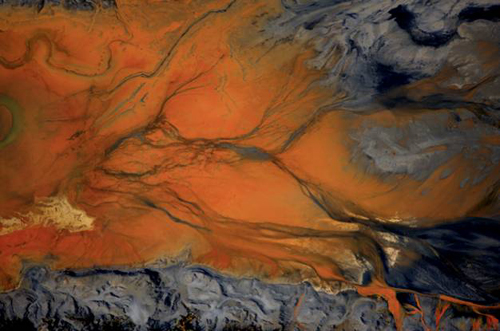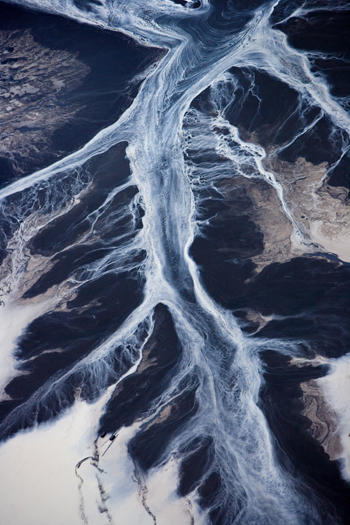Having grown up in Charleston, with much of my identity shaped by the customs and unique character of the land and the people, I care deeply about the welfare of the place.
My first exposure to art was at the Gibbes, and I remember anticipating the classes in the Queen Street annex with great pleasure. So when the Industrial Scars project reached a point of maturity, one of the first people to whom I showed it was Angela Mack, Executive Director at the Gibbes. She liked it and understood my intentions immediately, and suggested that an exhibit focused on the southeast would be particularly relevant and timely.
Of course, it took several years to go from planning to execution, which turned out to be a good thing as I used the interim to do some aerial shoots of the industries around Charleston. My intention in making these pictures is to make beautiful images that move people and stimulate dialog about these threats to us and our children. I do not aim to vilify any given company, because they are, as a rule, acting within the law.

As the show evolved, my research showed that my home town was besieged with millions of pounds of highly toxic pollutants that are affecting our health, lifestyle, and our ability to think clearly. Several photographs in the exhibition illustrate the waste from nearby coal-fired power plants impacting our natural resources (remember that these facilities are all operating within the law). Agent Orange depicts fly ash slurry from a coal-fired electrical generation station. When ash comes into contact with water, contaminants including arsenic, lead, mercury, selenium and others can migrate into groundwater, lakes, and streams.1
I discovered that the industries within a 100 mile radius of the Holy City emit almost 1000 pounds of mercury into the air annually. According to the EPA, “Symptoms of mercury poisoning include: tremors; emotional changes (e.g., mood swings, irritability, nervousness, excessive shyness); insomnia; neuromuscular changes (such as weakness, muscle atrophy, twitching); headaches; disturbances in sensations; changes in nerve responses; performance deficits on tests of cognitive function. At higher exposures there may be kidney effects, respiratory failure and death.” 2 And if you thought that 1000 pounds of this element is not so much to worry about, symptoms appear with as small a dose as 0.025 mg. I am often amazed by the willingness to class “the environment” as a special interest, when in fact, it is nothing more than the set of natural systems that sustain life on this planet.

Coal Slurry captures waste impoundments in West Virginia. Coal must be washed with water and processed with a variety of chemicals before it is used. This creates tremendous volumes of “slurry” which are stored in impoundments created by building earthen dams across the edges of valleys. On numerous occasions impoundments have failed, releasing large quantities of the toxic mixture to devastate the valley below.3
I take issue with the oft repeated mantra that we cannot do anything about the environment as it will cost jobs. My experience is exactly the opposite: in West Virginia, where coal mining is king, the shift to extraction by mountain-top removal, a much more damaging technique than traditional deep mines has simultaneously obviated 90% of the coal mining jobs due to mechanization.
Is saving a few pennies per kilowatt of electricity worth these results?
—J. Henry Fair, photographer and guest blogger
Fair will be at the Gibbes at noon on Saturday, February 26, to sign copies of his new book The Day After Tomorrow: Images of Our Earth in Crisis.
J. Henry Fair: Industrial Scars is on view at the Gibbes Museum through March 27. His photographs are also on view at the The Cooper Union in New York City.
For more information on the state of the environment where you live, visit the United States Environmental Protection Agency homepage and enter your ZIP code in the text field labeled MyEnvironment.
1 Environmental Integrity Project and Earthjustice. Coal Ash Waste Contamination Study – 31 New Water Pollution Cases | Earthjustice. Earthjustice: Environmental Law: Because the Earth Needs a Good Lawyer | Earthjustice. 24 Feb. 2010. Web. 25 Feb. 2011. http://earthjustice.org/news/press/2010/coal-ash-waste-contamination-study-31-new-water-pollution-cases.
2 “Health Effects | Mercury | US EPA.” US Environmental Protection Agency. Web. 24 Feb. 2011 http://epa.gov/hg/effects.htm.
3 United States of America. Environmental Protection Agency. Office of Solid Waste. Coal Combustion Waste Damage Assesment. United States Environmental Protection Agency, 9 July 2007. Web. 25 Feb. 2011. http://www.publicintegrity.org/assets/pdf/CoalAsh-Doc1.pdf (PDF).
Published February 25, 2011

